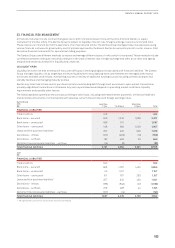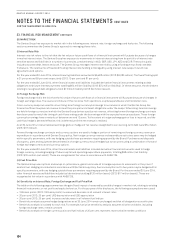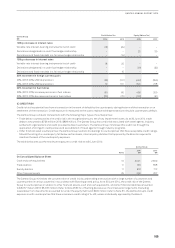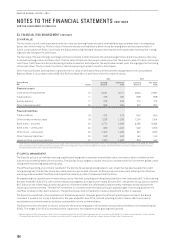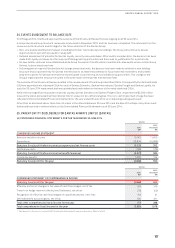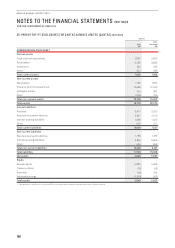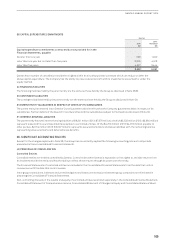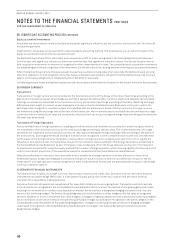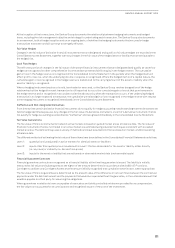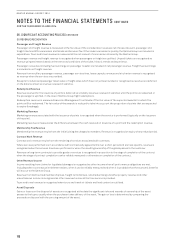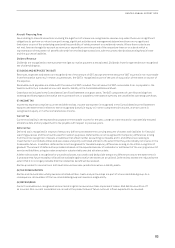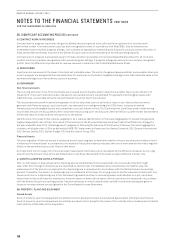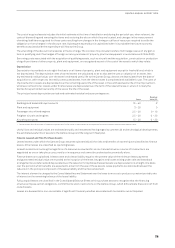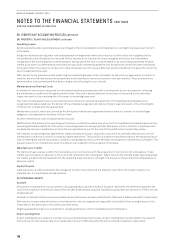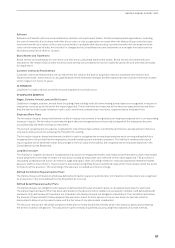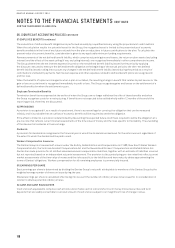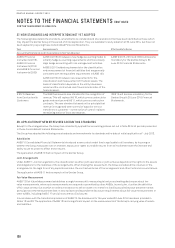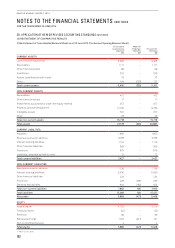Qantas 2014 Annual Report Download - page 115
Download and view the complete annual report
Please find page 115 of the 2014 Qantas annual report below. You can navigate through the pages in the report by either clicking on the pages listed below, or by using the keyword search tool below to find specific information within the annual report.
113
QANTAS ANNUAL REPORT 2014
Aircraft Financing Fees
Fees relating to linked transactions involving the legal form of a lease are recognised as revenue only when there are no significant
obligations to perform or refrain from performing, significant activities and management determines there are no significant
limitations on use of the underlying asset and the possibility of reimbursement is considered remote. Where these criteria are
not met, fees are brought to account as revenue or expenditure over the period of the respective lease or on a basis which is
representative of the pattern of benefits derived from the leasing transactions, with the unamortised balance being held in lease
and hire purchase liabilities.
Dividend Revenue
Dividends are recognised as revenue when the right to receive payment is established. Dividends from foreign entities are recognised
net of withholding tax.
(E) GOODS AND SERVICES TAX (GST)
Revenues, expenses and assets are recognised net of the amount of GST, except where the amount of GST incurred is not recoverable
from the taxation authority. In these circumstances, the GST is recognised as part of the cost of acquisition of the asset or as part of
the expense.
Receivables and payables are stated with the amount of GST included. The net amount of GST recoverable from, or payable to, the
taxation authority is included as a current asset or liability in the Consolidated Balance Sheet.
Cash flows are included in the Consolidated Cash Flow Statement on a gross basis. The GST components of cash flows arising from
investing and financing activities which are recoverable from, or payable to, the taxation authority are classified as operating cash flows.
(F) INCOME TAX
Income tax expense comprises current and deferred tax. Income tax expense is recognised in the Consolidated Income Statement
except to the extent that it relates to items recognised directly in equity or in other comprehensive income, in which case it is
recognised in equity or in other comprehensive income.
Current Tax
Current tax liability is the expected tax payable on the taxable income for the year, using tax rates enacted or substantially enacted
at balance date and any adjustment to tax payable with respect to previous years.
Deferred tax
Deferred tax is recognised in respect of temporary differences between the carrying amounts of assets and liabilities for financial
reporting purposes and the amounts used for taxation purposes. Deferred tax is not recognised for temporary differences arising
from the initial recognition of assets or liabilities that affect neither accounting nor taxable profit, and differences relating to
investments in controlled entities and associates and jointly controlled entities to the extent that they will probably not reverse in the
foreseeable future. In addition, deferred tax is not recognised for taxable temporary differences arising on the initial recognition of
goodwill. The amount of deferred tax provided is based on the expected manner of realisation or settlement of the carrying amount of
assets and liabilities, using tax rates enacted or substantially enacted at balance date.
A deferred tax asset is recognised for unused tax losses, tax credits and deductible temporary differences only to the extent that it
is probable that future taxable profits will be available against which the asset can be utilised. Deferred tax assets are reduced to the
extent that it is no longer probable that the related tax benefit will be realised.
Qantas provides for income tax in both Australia and overseas jurisdictions where a liability exists.
(G) TAX CONSOLIDATION
Qantas and its Australian wholly owned controlled entities, trusts and partnerships are part of a tax consolidated group. As a
consequence, all members of the tax consolidated group are taxed as a single entity.
(H) RECEIVABLES
Current receivables are recognised and carried at original invoice amount less impairment losses. Bad debts are written off
asincurred. Non-current receivables are carried at the present value of future net cash inflows expected to be received.


